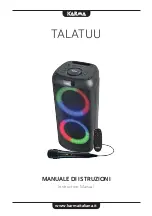
9
will run on either. The work return lead is then
connected to the opposite terminal. Electrode
negative operation will usually give better
positional welding characteristics. The output
characteristics of the power source can have an
effect on the quality of the welds produced.
The wire feed unit takes the filler wire from
a spool or bulk pack, and feeds it through the
welding gun, to the arc at a predetermined and
accurately controlled speed. Normally, special
knurled feed rolls are used with metal-cored
wires to assist feeding and to prevent crushing
the consumable.
Unlike MIG, which uses a solid consumable
filler wire, the consumable used in MCAW is
of tubular construction, an outer metal sheath
being filled entirely with metal powder except
for a small amount of non-metallic compounds.
These are added to provide some arc stability
and de-oxidation.
MCAW consumables always require an auxiliary
gas shield in the same way that solid MIG wires
do. Wires are normally designed to operate in
argon-carbon dioxide or argon-carbon dioxide-
oxygen mixtures or carbon dioxide. Argon rich
mixtures tend to produce lower fume levels
than carbon dioxide.
As with MIG, the consumable filler wire and
the shielding gas are directed into the arc area
by the welding gun. In the head of the gun, the
welding current is transferred to the wire by
means of a copper alloy contact tip, and a gas
diffuser distributes the shielding gas evenly
around a shroud which then allows the gas
to flow over the weld area. The position of
the contact tip relative to the gas shroud may
be adjusted to limit the minimum electrode
extension.
Modes of metal transfer with MCAW are very
similar to those obtained in MIG welding, the
process being operable in both ‘dip transfer’
and ‘spray transfer’ modes. Metal-cored wires
may also be used in pulse transfer mode at low
mean currents, but this has not been widely
exploited.
Process Schematic Diagram for MIG / FCAW and MCAW
1
Gas hose
7
Power cable
2
Gas cylinder
8
Gun conduit
3
Power source
9
Welding gun
4
Return cable
10
Arc
5
Continous wire
11
Workpiece
6
Wire feed unit
12
Earth clamp
1
2
3
4
5
6
7
8
11
12
9
10
Circuit diagram of MIG process
Modes of Metal Transfer
The mode or type of metal transfer in MIG
welding depends upon the current, arc voltage,
electrode diameter and type of shielding gas
used. In general, there are four modes of metal
transfer.
Modes of metal transfer with FCAW are similar
to those obtained in MIG welding, but here the
mode of transfer is heavily dependent on the
composition of the flux fill, as well as on current
and voltage.
The most common modes of transfer in
FCAW are:
Dip transfer
■
Globular transfer
■
Spray transfer
■
Pulsed arc transfer operation has been
■
applied to flux-cored wires but, as yet, is
not widely used because the other transfer
modes are giving users what they require, in
most cases.
Dip Transfer
Also known as short-circuiting arc or short-
arc, this is an all-positional process, using low
heat input. The use of relatively low current










































